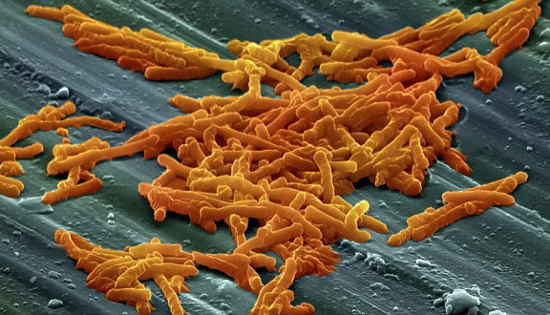The cause of drug resistance is detected
After analyzing DNA from Clostridium difficile (C-difficile) virus samples taken from hospitals around the world during the period of 1985-2010, British gene researchers on December 9 He said he found the cause of C-difficile virus outbreak and spread quickly around the world in a short time.
The results of the study were published in Nature Genetics.
After studying the "genealogical tree" of C-difficile virus for many years, scientists found that this dangerous virus spreads the disease through two different strains, but it is closely related to FQR1 and FQR2. This finding is completely different from previous scientific publications.

The type of drug-resistant virus called Clostridium
difficile under a microscope has been discovered in Europe recently.
The two strains of FQR1 and FQR2 have isolated genes that make them "immune" to "fluoroquinolone" , which is considered an effective antibiotic for C-difficile infections.
Professor Brendan Wren of the London London School of Tropical and Hygiene School says that since the strains of bacteria on resistance, they are not only immune to antibiotics but seem to be resistant to this strain of bacteria. more powerful and durable.
The C-difficile epidemic caused by the FQR1 strain first broke out in Pittsburgh, Pennsylvania, USA in 2001, then spread from the Northeast of the United States to South Korea and Switzerland. Meanwhile, the first outbreak of the FQR2 strain was discovered in Montreal city in Canada in 2003. After infection in North America, the strain appeared in Australia and spread to continental Europe.
Since 2002-2006, the C-difficle resistant virus has spread in almost all hospitals in the United Kingdom, the United States, Canada, and Europe and then quickly becomes a fire hazard to overall health. bridge. According to statistics in 2009, C-difficile has infected 500,000 people, about 15,000-20,000 deaths in the United States each year because diarrhea in the diarrhea is severe.
C-difficile lives in the digestive system of humans and animals such as dogs, cats, buffaloes, cows, horses and rodents. This bacterium causes disease by the mechanism of toxin production, causing mild to acute diarrhea leading to death. Common symptoms are liquid diarrhea, which may have blood or mucus, abdominal pain, fever, rapid heartbeat.
- Increasing popularity of new drug-resistant TB strains
- New breakthrough in the fight against drug resistance
- Solving the phenomenon of drug resistance by giving bacteria 'fighting' together
- Find the clues that cause cancer resistance
- Concerns about drug resistance of H7N9 virus
- Cancer patients will no longer suffer side effects thanks to new research
- Detection of weaknesses of drug resistance
- Drug resistance of the virus
- Poor immune system makes it easier to resist influenza virus
- Resistant bacteria can spread through the air, and this is not good news
- Etravirine: New drug against HIV drug resistance
- The golden age of antibiotics is over, the immediate future will be a nightmare for humans
 Why do potatoes have eyes?
Why do potatoes have eyes? 'Tragedy' the world's largest carnivorous life: Death becomes ... public toilet
'Tragedy' the world's largest carnivorous life: Death becomes ... public toilet Tomatoes were once considered 'poisonous' for 200 years
Tomatoes were once considered 'poisonous' for 200 years Detecting microscopic parasites on human face
Detecting microscopic parasites on human face